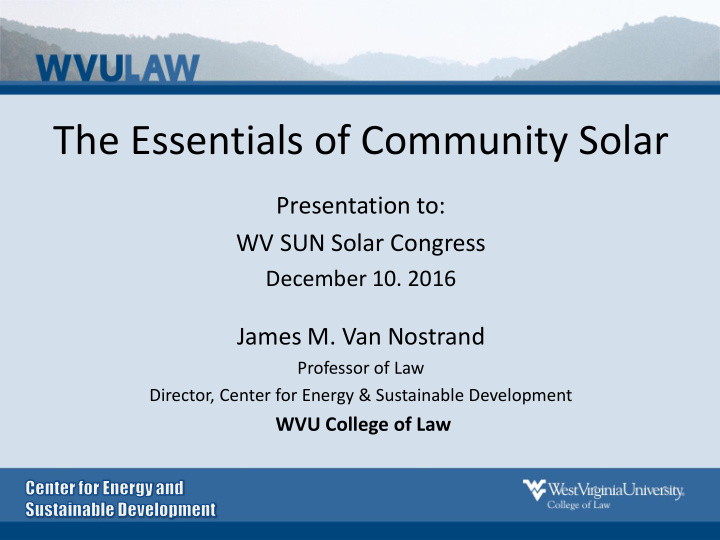



The Essentials of Community Solar Presentation to: WV SUN Solar Congress December 10. 2016 James M. Van Nostrand Professor of Law Director, Center for Energy & Sustainable Development WVU College of Law
What is Community Solar? • Centralized solar facilities owned by a group of individuals who receive credits on their electricity bills for the power produced • Members of an array are residential and commercial customers of the utility partner offering the program (utility-sponsored model)
What is Community Solar?
Community Solar Projects • Community Solar Hub – 98 Projects – 25 States – 100,546 total kW https://www.communitysolarhub.com/
What is Community Solar? • Utility-Sponsored Model , in which a utility owns or operates a project that is open to voluntary ratepayer participation • Special Purpose Entity (SPE) Model , in which individual investors join in a business enterprise to develop a community solar project • Non- Profit “Buy a Brick” Model , in which donors contribute to a community installation owned by a charitable non-profit corporation
Utility-Sponsored Model • Utility customers participate by contributing either an up-front or ongoing payment to support a solar project • In exchange, customers receive a payment or credit on their electric bills that is proportional to 1) their contribution and 2) how much electricity the solar project produces • Usually, the utility or some identified third party owns the solar system itself • The participating customer has no ownership stake in the solar system. Rather, the customer buys rights to the benefits of the energy produced by the system • Utility-sponsored community solar programs are distinct from traditional utility “green power” programs in that “green power” programs sell RECs from a variety of renewable energy resources; utility community solar programs sell energy or rights to energy from a specific solar installation, with or without the RECs • Utility-sponsored programs can help make solar power more accessible by decreasing the amount of the purchase required, and by enabling customers to purchase solar electricity in monthly increments
Utility-Sponsored Model
Utility-Sponsored Model • Example: Seattle City Light http://www.seattle.gov/light/solarenergy/ commsolar.asp
Special Purpose Entity Model • To take advantage of the tax incentives available to commercial solar projects, organizers may choose to structure a project as a business • In most states, there is a range of business entities that could be suitable for a participant-owned community solar project • The main challenges in adapting these commercial solar structures for community projects include: – Fully using available tax benefits when community investors have limited tax appetite, including a lack of passive income – Maintaining the community project identity when engaging non-community-based tax-motivated investors – Working within limits on the number of unaccredited investors if the project is to be exempt under securities laws
Special Purpose Entity Model
• Special Purpose Entity Model
Non-Profit Model • Not strictly “community solar” in that the donors do not share directly in the benefits of the solar installation • Donors do share indirectly, by lowering energy costs for their favored non-profit and demonstrating environmental leadership • In addition, with emerging state policies such as virtual net metering and group billing, there may be possibilities for a non-profit project sponsor to share benefits with their donor/members • In a variation on non-profit ownership, a non-profit may partner with a third party for-profit entity, which can own and install the system and take the tax benefits
Non-Profit Model
Non-Profit Model
Summary of Models
State Policies to Promote Community Solar • Group Billing – A utility produces a group bill showing all participants’ energy consumption and relevant charges – Output from a shared PV system is netted against the group bill – The remaining costs are allocated to participants according to an agreement between the participants – Under this framework, group billing allows multiple participants to receive net-metering credits from a single renewable energy facility
State Policies to Promote Community Solar • Virtual Net Metering – Virtual net metering allows net metering credits generated by a renewable system to offset load at multiple retail electric accounts within a utility’s service territory – Under virtual net metering, credits appear on each individual customer’s bill the same as they would under traditional net metering
State Policies to Promote Community Solar • Joint Ownership – A few states have begun to explore options for distributing benefits of participation in a community renewables program through frameworks akin to wholesale power sale arrangements – Enter into a long-term contract to sell output from a facility to a transmission and distribution utility
Thank You James M. Van Nostrand Professor of Law Director, Center for Energy and Sustainable Development West Virginia University College of Law james.vannostrand@mail.wvu.edu (304) 293-4694 energy.law.wvu.edu law.wvu.edu
Recommend
More recommend